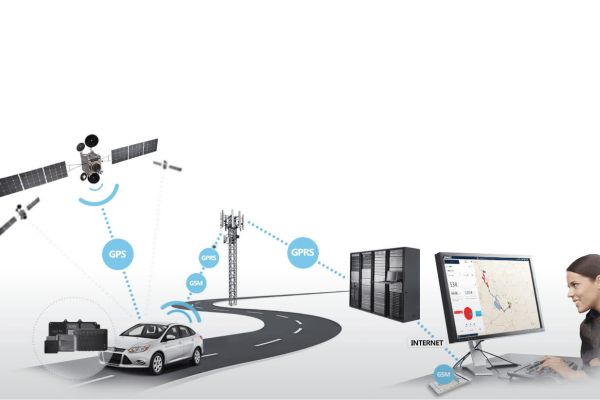The global vehicle tracking systems market size is expected to surge around USD 99.56 billion by 2034 from USD 27.64 billion in 2024 with a notable CAGR of 13.67%. The North America vehicle tracking systems market size was calculated at USD 9.12 billion in 2024 and is expanding at a CAGR of 13.70% during the forecast period.
Vehicle Tracking Systems Market Key Points
- In 2024, North America accounted for the highest revenue share of 33%.
- Asia-Pacific is projected to experience the fastest CAGR between 2025 and 2034.
- The passenger vehicles segment led the market in 2024, generating the largest share of 41%.
- The light commercial vehicles segment is expected to grow significantly at a notable CAGR during the forecast period.
- The GPS/satellite technology segment dominated the market with the highest share in 2024.
- The software component held the largest revenue share of 66% in 2024.
The Role of AI in Vehicle Tracking Systems
AI is transforming the vehicle tracking systems market by enabling real-time data analysis and predictive capabilities. AI algorithms process data from vehicles, such as location, speed, and driver behaviour, to optimize routes, improve fuel efficiency, and ensure timely deliveries.
Additionally, AI-powered systems can predict maintenance needs, reducing unexpected breakdowns and downtime, while also monitoring driver behaviour to enhance safety by detecting risky actions like speeding or harsh braking. Moreover, AI plays a crucial role in automating compliance reporting, tracking regulatory standards, and enhancing vehicle security.
By integrating AI with IoT devices, vehicle tracking systems can offer smarter solutions, such as real-time route optimization, theft prevention through geofencing, and better coordination with smart infrastructure. This integration leads to more efficient fleet management, cost savings, and enhanced safety for both drivers and vehicles.
What is a Vehicle Tracking System?
A Vehicle Tracking System (VTS) is a technology used to monitor and track the location, movements, and behaviour of vehicles in real-time. It typically involves the use of GPS (Global Positioning System) or other satellite-based tracking systems, sensors, and telematics to gather data, which is then sent to a central system or dashboard for analysis and monitoring.
Components of a Vehicle Tracking System
- GPS Tracker: The core component that collects location data and transmits it to a central monitoring system.
- Telematics Unit: Collects additional data from the vehicle, such as speed, fuel consumption, engine performance, and driver behaviour.
- Communication System: Typically uses cellular, satellite, or Wi-Fi networks to transmit data from the vehicle to the central system.
- Monitoring Software: Centralized software that displays real-time information about vehicle location, route, and other parameters, accessible via web or mobile platforms.
- Sensors: Devices that monitor factors like engine temperature, fuel level, tire pressure, or door status, helping to provide more detailed insights into the vehicle’s performance.
Applications of Vehicle Tracking Systems
- Fleet Management: Used extensively by logistics companies, delivery services, and transportation businesses to track vehicle locations, monitor driver behaviour, and optimize routes for efficiency.
- Public Transportation: Helps improve scheduling and customer experience by providing real-time tracking of buses, taxis, and other public transport vehicles.
- Personal Vehicle Tracking: Used for personal security or theft prevention, allowing owners to monitor the location of their vehicles.
- Logistics and Supply Chain: Enables real-time monitoring of delivery vehicles, improving route planning, fuel efficiency, and ensuring timely deliveries.
- Insurance: Helps insurance companies offer usage-based policies by tracking the vehicle’s driving habits and providing data for customized premiums.
Benefits of Vehicle Tracking Systems
- Improved Fleet Efficiency: Allows fleet operators to monitor vehicle routes, reduce idle times, and optimize travel paths, resulting in fuel savings and faster delivery times.
- Enhanced Security: Vehicle tracking enhances theft prevention with real-time alerts if a vehicle moves outside a designated area (geofencing), and aids in recovery in case of theft.
- Predictive Maintenance: By monitoring vehicle health and performance metrics, tracking systems help schedule timely maintenance, preventing breakdowns and costly repairs.
- Driver Behaviour Monitoring: Tracking systems can assess driver behaviour, such as speeding, harsh braking, or idling, and provide feedback or reports to improve safety and reduce accidents.
- Real-Time Visibility: Operators can access real-time data to make informed decisions, improving responsiveness to unexpected situations like traffic, delays, or vehicle malfunctions.
Current Trends in Vehicle Tracking Systems
- Integration with IoT and AI: AI and IoT integration allows for predictive maintenance, real-time decision-making, and smarter routing systems that improve operational efficiency.
- Electric Vehicle (EV) Tracking: With the rise of electric vehicles, tracking systems are evolving to include parameters specific to EVs, such as battery status and charging patterns.
- Cloud-Based Platforms: Cloud technology is enabling more flexible, scalable, and cost-effective solutions for storing and accessing vehicle data, improving fleet management capabilities.
- Telematics and Data Analytics: Data-driven insights are becoming more sophisticated, helping companies analyse performance, identify inefficiencies, and make smarter business decisions.
- Integration with Smart Cities: Vehicle tracking systems are becoming integrated with smart city infrastructure, helping with real-time traffic management, public transportation scheduling, and improved urban planning.
Market Scope
| Report Coverage | Details |
| Market Size by 2034 | USD 99.56 Billion |
| Market Size in 2025 | USD 31.60 Billion |
| Market Size in 2024 | USD 27.64 Billion |
| Market Growth Rate from 2025 to 2034 | CAGR of 13.67% |
| Largest Market | North America |
| Base Year | 2024 |
| Forecast Period | 2025 to 2034 |
| Segments Covered | Vehicle Type, Technology, Component |
| Regions Covered | North America, Europe, Asia-Pacific, Latin America, and Middle East & Africa |
Regional Outlook of the Vehicle Tracking Systems Market
North America
- Market Size: The North America vehicle tracking systems market was estimated at USD 9.12 billion in 2024.
- Growth: It is expanding at a CAGR of 13.70% during the forecast period.
- Market Share: North America accounted for over 33% of the global market share in 2024.
- Key Countries: The U.S. and Canada are the major contributors in this region.
- U.S. Market: The U.S. vehicle tracking systems market was valued at USD 6.39 billion in 2024 and is expected to reach around USD 23.20 billion by 2034, growing at a CAGR of 14% from 2025 to 2034. Driven by technological advancements and rising investments in advanced tracking devices.
- Canada Market: Gaining traction due to government regulations for integrating trackers in vehicles and increased focus on enhancing operational efficiency.
Asia Pacific
- Dominant Country: China held the dominant position in the industry.
- Growth Factors (China): Increased sales of passenger vehicles and a well-established automotive aftermarket industry.
- Other Key Countries: India, Japan, and South Korea also held a substantial share of the market.
- Growth Factors (India): Boosted by the rising cases of thefts.
- Growth Factors (Japan): Driven by the rise in the number of ride-sharing platforms.
- Growth Factors (South Korea): Driven by the presence of automotive companies such as Hyundai, Kia, Genesis, and Daewoo Motors.
Segmental Analysis of the Vehicle Tracking Systems Market
Vehicle Type Insights
- Passenger Vehicles: This segment held over 41% of the market share in 2024. The growth is attributed to increased production, sales, and adoption of passenger vehicles, rising disposable income, increased urbanization, and the growing need for private transport. The rising penetration of electric vehicles is expected to further drive demand.
- Light Commercial Vehicles: This segment is expected to be the fastest growing during the forecast period, driven by the increasing adoption of light commercial vehicles due to the rising e-commerce industry.
Technology Insights
- GPS/Satellite: This segment dominated the global vehicle tracking systems market in 2024 and is estimated to maintain its dominance during the forecast period. The ability of GPS/satellite technology to work with other technologies like WiMAX, GSM, and LTE has boosted its adoption. Increased efficiency and rising popularity have made it the fastest-growing segment.
Component Insights
- Software: This segment accounted for over 66% of the market share in 2024, driven by a rapid surge in the number of software solution providers. The software provides solutions like vehicle maintenance, route optimization, vehicle diagnostics, driver management, and fuel management.
- Hardware: This segment is estimated to be the most opportunistic during the forecast period. The hardware consists of devices such as trackers and onboard diagnostic devices. Wireless Bluetooth connectivity and enhanced performance of the hardware are boosting the growth of this segment.
Vehicle Tracking Systems Market Companies
- CalAmp
- Cartrack Holdings Limited
- Continental Ag
- Geotab Inc.
- Trackimo
- Teltonika
- TeletracNavman US
- Tomtom, Inc.
- Verizon Communication Inc.
- Xirgo Technologies, LLC.
Source: https://www.precedenceresearch.com/vehicle-tracking-systems-market

















